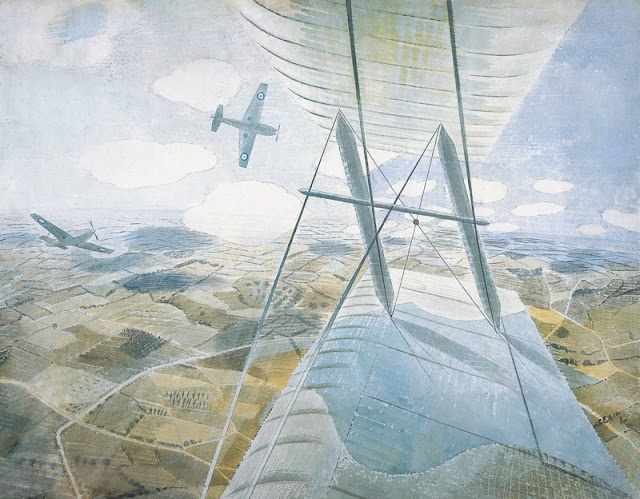 |
| Eric Ravilious, Hurricanes in Flight, 1942 (DACS/Artist's Estate) |
This Sunday, to commemorate the 70th anniversary of the artist's disappearance, Alan Powers and I will each be giving an illustrated talk at the Birley Centre in Eastbourne, for the Friends of the Towner Art Gallery. I will be exploring the life and work of Ravilious the watercolourist, looking in depth at a number of his Sussex pictures and endeavouring to give a flavour of the artist and his times. There's a tendency these days to see him as rather an austere character - a haunter of solitary Downland ways - and I hope to show him as someone much more human, brilliant but down to earth.
 |
| Ravilious in uniform |
I appreciate that fashions change, but I find it hard to believe that the people who enjoyed David Inshaw's work so much in the 1970s wouldn't have flocked to a Ravilious show. How could the painter of 'Train Landscape' and 'Chalk Paths', not to mention the designer of the Alphabet series, fall so far out of favour? All I can think of is that, with no monograph to encourage interest and only the occasional exhibition, people just didn't know about him. That they do now is thanks primarily to Anne Ullmann, Eric's daughter, who edited two major books on his work for the Fleece Press.
Anne was only a toddler when her father disappeared, but though she may have been too young to remember him properly, I wonder whether some recollection of his presence stayed with her. Few people remain alive who remember Eric Ravilious, however there have been in recent years several rather miraculous instances of lost artworks and artifacts returning from oblivion. Last year it was his dummy for a Puffin Picture Book on White Horses, and a few years before that a pair of early watercolours that turned up among the effects of a collector in Surrey.
On Tuesday 4th September a new find is up for auction at Sworders' auction house in Stanton Mountfitchet: five of the auto-lithographs made by Ravilious in 1940/41 and known nowadays as the Submarine Series. These were apparently found shoved down the side of a bed in north London, though whose bed it was and how they got there I have no idea. Sworders had great success with the White Horse Dummy, which was bought by the Museum of Wiltshire Life in Devizes, and they're hoping the new find will prove equally popular.
 |
| Eric Ravilious, Introductory Drawing (aka Submarine Dream), auto-lithograph, 1941 |
Whether these five prints end up in a public institution or in a private collection, it's wonderful that they have reappeared after so long, to be enjoyed as they should be. And don't despair if you're not planning to bid: the full Submarine Series plus a number of the artist's preparatory drawings will be published this autumn by the Mainstone Press in a beautiful new book, 'Ravilious: Submarine'.


3 comments:
Your post raises many interesting questions about fame and how people fall in and out of fashion particularly in the very fickle world of art.
And not just the visual arts - what was that Nick Drake song?
Fame is but a fruit tree
So very unsound
It can never flourish
Till its stalk is in the ground
Certainly true in his case. The man couldn't sell a record in his lifetime, now he's better known than most of his peers...
Hello sorry for the change of subject . Please can anyone point me in the right direction for Ravilious's letters, diary comments written about him in 1942 whilst he was at The Sawbridgeworth Base. Are these if they exist available for public. Any help would be much appreciated as I have been going around in fruitless internet circles.
Post a Comment